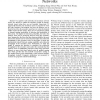Free Online Productivity Tools
i2Speak
i2Symbol
i2OCR
iTex2Img
iWeb2Print
iWeb2Shot
i2Type
iPdf2Split
iPdf2Merge
i2Bopomofo
i2Arabic
i2Style
i2Image
i2PDF
iLatex2Rtf
Sci2ools
108
Voted
ICC
2007
IEEE
2007
IEEE
Sensing-Throughput Tradeoff for Cognitive Radio Networks
— In cognitive radio networks, the secondary network (users) are allowed to utilize the frequency bands of primary network (users) when they are not currently being used. To support this function, the secondary users are required to sense the radio frequency environment, and once the primary user is found to be active, the secondary users have to vacate the channel within certain amount of time. There are two parameters related to channel sensing: probability of detection and probability of false alarm. The higher the detection probability, the better the primary users can be protected. However, from the secondary users’ perspective, the lower the false alarm probability, the more chances the channel can be reused, thus the higher the achievable throughput for the secondary users. In this paper, we study the fundamental tradeoff between sensing capability and achievable throughput of the secondary users. Particularly, we study the design of sensing slot duration to maximize the ach...
Related Content
| Added | 02 Jun 2010 |
| Updated | 02 Jun 2010 |
| Type | Conference |
| Year | 2007 |
| Where | ICC |
| Authors | Ying-Chang Liang, Yonghong Zeng, Edward Chu Yeow Peh, Anh Tuan Hoang |
Comments (0)

